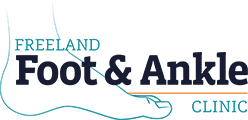Shoe shopping can be a nightmare.
You're looking for something cute, trying to avoid skimping on comfort and support, but you're getting lost in a sea of different brands with different promises. You're struggling with a general confusion surrounding one vital thing:
Your shoe size.
What is your shoe size? Do you know it off the top of your head? Are the pair of shoes you're wearing right now the correct size? When standing in a store's disorganized, overwhelming shoe section, all these questions might run through your head. If you order shoes online, you're probably dealing with the same problem.
Thankfully, today's blog will give you tips and tricks to ensure you get the perfect fit every time you buy a pair of shoes.
![multiple colors of high heels set in front of a color-block background]() Is It Better to Size Up or Down in Shoes?
Is It Better to Size Up or Down in Shoes?
Before I give you the secrets of shoe sizing that only a podiatrist could know, let's talk about why wearing the right shoes is essential. Here's a question I get all the time:
"Is it better to wear shoes that are too big or too small?"
You should wear shoes that fit properly. Wearing shoes that are too big will lead to excessive rubbing of the toes and heels. Too tight-shoes are uncomfortable and can lead to blisters, abrasions, and inflammation. A properly-fitted pair of shoes is especially important for those with diabetes, neuropathy, and other conditions that make foot injuries especially dangerous.
That said, you may struggle with swelling in your feet for various reasons, from diabetes to pregnancy. You should still measure your foot when it is not swollen. Swelling in the feet should not be so severe that it causes a drastic change in your shoe size, meaning it shouldn't even increase by a half-size. If that is the case and you are experiencing serious foot-swelling or lymphedema, you should wear compression socks and make an appointment to be evaluated by a professional.
What Happens to My Feet if My Shoes Don't Fit?
Ill-fitting shoes, whether they are too big or too small, can lead to problems like:
- Ingrown toenails
- Blisters
- Diabetic-foot related issues like wounds and ulcers
- General discomfort
- Inflammation
- Corns and calluses
- Discolored, damaged, and sore toenails
- Athlete's foot and fungal infections of the toenails
- Hammertoes and other foot deformities
It may seem like "no big deal" to wear shoes that are too tight or too big every once in a while, but long-term use of ill-fitting shoes can lead to serious foot problems, some of which could require lengthy, expensive treatment and even surgery. Many women who were forced to squeeze into tiny, narrow heels throughout lengthy professional careers now suffer from serious issues that affect them every day. It may seem worth it, in the name of fashion, but it's not.
All in all, your shoes shouldn't be too tight or too loose. Keep reading to learn how to get them just right.
How to Measure Your Feet and Pick the Right Pair of Shoes
First, you should consider taking into account the shape of your feet when picking a pair of shoes. For women especially, heels and certain styles of flats are narrow. For those with wider feet, a shoe that's too narrow will cause blisters and other issues (like the ones I listed above). Look for wider styles, and if your employer requires a certain type of footwear you can find a specialty shoe store to find shoes that fit your dress code without sacrificing the health of your feet.
High heels are not recommended if you suffer from heel pain, plantar fasciitis, Achilles tendonitis, or metatarsalgia. If you must wear them for work, look for short, wide heels with plenty of room in the toe. Obtaining a note to excuse you from a certain shoewear requirement based on a medical condition is also an option for those with more severe issues.
Buying shoes is best-done in-store. You should measure your feet every time you buy new shoes in case they changed. Shoe sizes can change for a variety of reasons:
- weight loss or weight gain
- pregnancy
- aging or age-related bone loss
- arthritis
- and more
 Additionally, each brand and every style fits differently, with some brands offering their own unique size guides. Be sure to buy shoes based on fit rather than size. For example, imagine that you wear a size six. You go to the store and try on a pair of Nike Air Force 1's in size eight, and they fit you perfectly, even though that is not your typical size. Next, you try a pair of Adidas trainers, a brand that notoriously runs more true-to-size than Nike, which might fit perfectly at a size six.
Additionally, each brand and every style fits differently, with some brands offering their own unique size guides. Be sure to buy shoes based on fit rather than size. For example, imagine that you wear a size six. You go to the store and try on a pair of Nike Air Force 1's in size eight, and they fit you perfectly, even though that is not your typical size. Next, you try a pair of Adidas trainers, a brand that notoriously runs more true-to-size than Nike, which might fit perfectly at a size six.
Aside from focusing on fit over size, here are more tips for getting a great-fitting pair of shoes:
- Make sure your toes don't touch the tip of your shoes. There should be enough room in the toe-box.
- Take a walk in the store. If you can't walk comfortably in your potential new shoes in the store, they certainly won't be any more comfortable once you get them home.
- Ask an associate about brands. They will know which brands run small, large, and true-to-size.
- Check the return policy. Ensure that you will be able to return your shoes if you aren't happy with them after your purchase.
- Ask a professional. Patients at Freeland Foot and Ankle Clinic often bring their new shoes in so I can examine and evaluate them, and this stamp of approval from a professional will give you peace of mind that you made the right choice.
What Should You Do If the Pain Doesn't Go Away?
If shoes alone aren't enough to get rid of your foot pain, it's time to take another step in the right direction. At your first appointment with Freeland Foot and Ankle, we will answer all your questions, explain our course of treatment, and send you home with tangible steps you can take to get back on your feet and back to your life. Stop letting heel pain, sports injuries, or other foot problems hold you back. Call or text us at 989-695-6788 to schedule your appointment today, and don't forget to ask us about same-day appointments.

 Is It Better to Size Up or Down in Shoes?
Is It Better to Size Up or Down in Shoes?